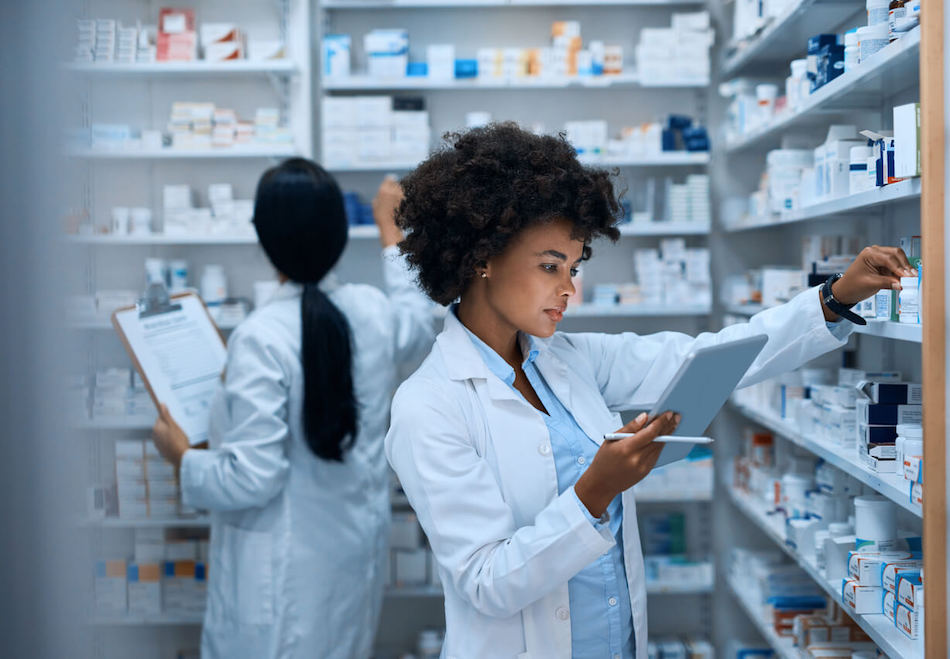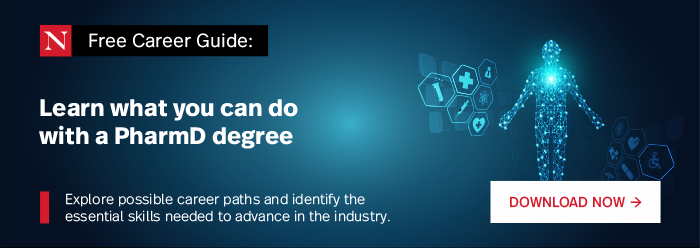If you’re considering a career as a pharmacist, then you probably already know that becoming one will require a significant investment of time and effort. To become a pharmacist, you’ll need to earn your Doctor of Pharmacy degree (PharmD), which typically takes between six and eight years to complete.
Those who complete this rigorous education, however, are rewarded with high pay, job security, and the satisfaction of knowing that their work has a tangible impact on the lives of others.
Before you decide to pursue this (or any) degree, it’s essential to understand the type of work that such a degree will prepare you for. Below, we take a closer look at exactly what a pharmacist does so that you will be better equipped to decide if becoming a pharmacist is the right move for you, or if there might be a different career and degree that better align with your goals.
What Is a Pharmacist?
A pharmacist is a healthcare professional who is specifically trained to store, handle, prepare, and dispense various medications.
They play an essential role in educating patients about using or administering their medications. Likewise, they serve as a “final check” to ensure that doses are correct and that a patient will not experience negative or harmful drug interactions.
Download Our Free Guide to Advancing Your Pharmacy Career
Learn how a PharmD can give you the skills for success in the industry.
Where do pharmacists work?
Pharmacists typically work in pharmacies. While most people think of a corner store like CVS, Duane Reade, or RiteAid when they hear the word “pharmacy,” pharmacies can be found in many different locations, and pharmacists’ specific duties can vary significantly depending on their work setting.
Pharmacists are commonly employed in:
- Community pharmacies
- Hospitals
- Cardiac care centers
- Oncology centers
- Specialty clinics
- Mental health facilities
- Addiction treatment centers
- Rehabilitation centers
- Nursing homes and long-term care facilities
- Hospice or home care centers
- Poison control centers
- Medication distribution centers
Simply put, anywhere that a patient might need medication prepared or distributed is likely to have a pharmacist on staff.
What Does a Pharmacist Do?
While the specific role of a pharmacist varies depending on where they work, their fundamental duties typically include some mix of the following:
- Verifying dosage on medications prescribed by health care providers
- Preparing prescriptions according to prescriber instructions
- Ensuring whether or not a particular medication will interact with other medications used by the patient
- Verifying that the patient is not otherwise at risk of adverse reactions caused by a prescription
- Educating patients about how and when to take or administer the prescription
- Advising patients about potential side effects of medication and answering any questions they may have
- Administering various vaccinations, such as flu shots
- Oversee and manage pharmacy interns and technicians
- Basic record-keeping and administrative tasks, as required
Types of Pharmacists
As mentioned above, there are different types of pharmacists who perform distinct tasks and duties as a part of their day-to-day functions. These include:
- Community Pharmacists: These are those pharmacists who work in community (retail) pharmacies. They primarily dispense medications and educate patients about their drugs, illnesses, over-the-counter medications, and more.
- Clinical Pharmacists: These pharmacists work in healthcare settings such as clinics, hospitals, or other locations. Clinical pharmacists typically spend a significant amount of time providing direct care to patients, recommending medications, and overseeing or adjusting dosages as necessary throughout treatment. They may also be involved in conducting medical tests or in educating patients.
- Consultant Pharmacists: These pharmacists provide consulting services to hospitals, insurance providers, and other healthcare centers, typically as a means of improving pharmacy services. They may also consult directly with patients about subjects such as prescription management.
- Pharmaceutical Industry Pharmacists: These pharmacists work in the pharmaceutical industry, and therefore have much less interaction with patients. They might be involved in the research and development of new medications or other areas such as sales and marketing.
How Much Do Pharmacists Make?
According to the U.S. Bureau of Labor Statistics (BLS), the average pharmacist in the United States earns approximately $128,700 per year as of 2021. That translates into an hourly wage of about $61.88 per hour.
Of course, individual earnings are impacted by several factors, including their level of experience, the type of facility in which they work, and their geographic location. For example, according to data compiled by Salary.com, the average pharmacist in Boston typically earns between $149,000 and $168,500 per year.
The BLS estimates that each year between 2020 and 2030, there will be 11,300 new openings for pharmacists. This growth will be driven by current pharmacists moving into new roles (such as teaching roles) and many current pharmacists choosing to retire.
Taking the First Step to Become a Pharmacist
If the job description, role, and responsibilities above all resonate with your professional aspirations, the first step toward your dream career is to complete the required education. This means earning your Doctor of Pharmacy degree (PharmD) and potentially completing a 1- or 2-year residency, depending on your specific career goals.
After completing your studies, you will need to pass two exams to qualify for licensure and practice: The North American Pharmacist Licensure Exam (NAPLEX) and the Multistate Pharmacy Jurisprudence Exam (MPJE). Some states require a state-specific test in place of the MPJE.
At Northeastern, our PharmD program is ranked #1 by the NIH among private pharmacy schools for research funding. Our program is affiliated with more than 120 hospitals, clinics, community pharmacies, private companies, and government agencies, and 100 percent of our students complete at least two four-month co-ops where they develop real-world expertise. Further, more than 98 percent of our 2020 graduates passed the NAPLEX licensure exam.
Learn more about earning your PharmD at Northeastern University or download our free career guide below.







Related Articles
PhD vs. Master’s in Biomedical Science: What’s the Difference?
10 Top Careers in Biomedical Science
What is Medicinal Chemistry?